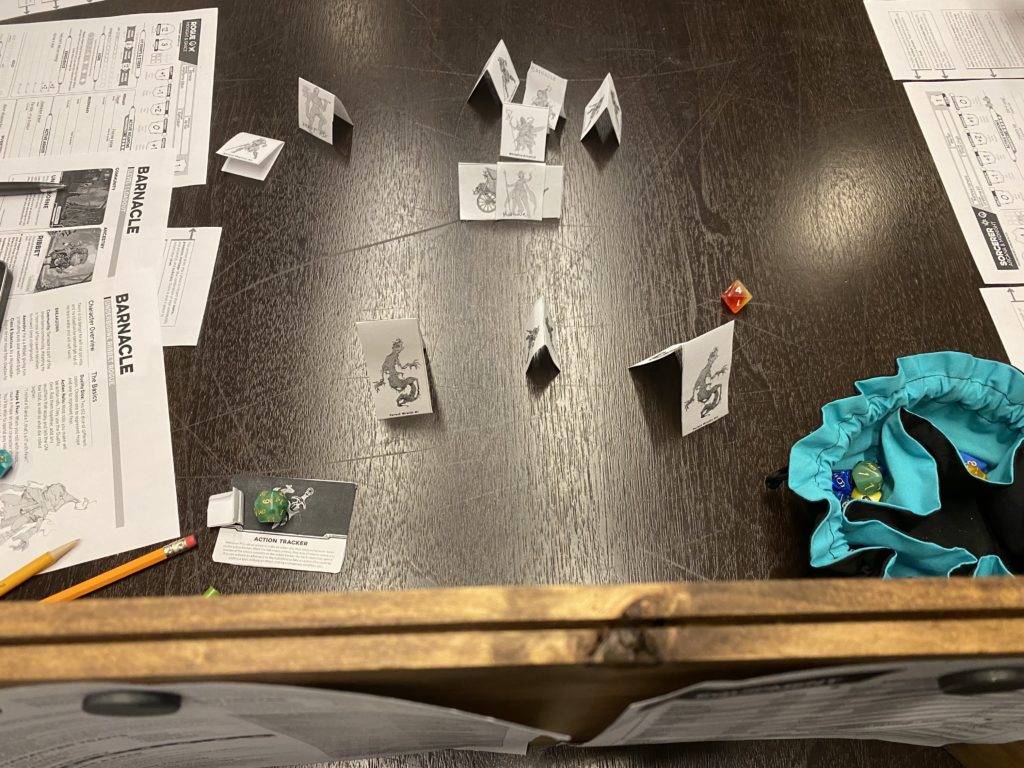A few weeks ago, I ran my first in-person Daggerheart session, and it went great. Of course, I ran The Sablewood Messengers again. This time, however, I ran with three players from an old Masks campaign who are all generally well-versed in playing TTRPGs.
Afterwards, I was happy with how the session went, but then I realized something important: I barely had to explain how the system works. For TTRPG veterans, Daggerheart is easy to learn and very intuitive.
My players sat down, picked characters, and we just played.
Allow me to explain further how it happened.
Duality dice just work
The Sablewood Messengers has many blurbs where the GM explains the rules system, and I ignored most of those. I briefly explained the duality dice and that the players had to always say if they rolled “with hope” or “with fear.” I was immediately waved off because graded success and failure was obvious to the players.
One would hope that the core action resolution, dice-rolling mechanic would be straightforward, but it can get surprisingly complicated in some systems. DH rides that line of being immediately familiar and accessible while also being unique.
Character sheet slide outs are great
Right after the players picked their characters, I had to step away from the table for a moment. During that time, they had cut out their, uh, cutouts, and they had setup the slide outs to explain their character sheets.
And I never looked at their character sheets all session. They didn’t ask me questions about where to find what, and they used things like Experiences with me barely mentioning their presence.
Abilities just work
Honestly, having only run DH games and never played, I have no idea what any of the class, domain, ancestry, or community abilities are. The players just read their abilities and used them. That was it.
The card system fits well into the design: by limiting the players’ options and clearly, physically separating them at any given time, the players just have a better sense for what their characters can do.
There’s more adjudication on how some of the abilities work: for example, the duration on Mysterious Mists is deliberately ambiguous. However, I personally found the details specific enough to be understood but broad enough for interpretation.
Combat flowed smoothly
For this session, I decided to fully buy into the cutouts and not use my gridded dry erase map. That was perfect because I explained ranges, and my players used their pencils through the entire fight to measure distances.

I told the players that they could act and use their abilities in any order whenever they wanted: all they had to do was for me to be ready to jump in at any time. Again, they just played and handed initiative back and forth without a problem.
Of course, it isn’t lawless: there’s plenty of tracking and mechanical precision for the GM to figure out. However, that was well-abstracted from my players that it wasn’t a problem at all.
So what isn’t easy to learn?
This system isn’t perfectly learnable. Four things stuck out to me.
First, armor. The damage thresholds were quick, but using armor slots and having players do math was clunky. From the pre-order recap, it sounds like they are doing away with this.
Second, a minor catch with reaction rolls is that they don’t grant hope and fear. It mechanically makes sense, and as soon as they players knew, they got it. However, it is the special case in an otherwise intuitive rule system.
Third, tag team. It’s a fun, in-practice optional rule, but it does take some explaining to get to. In some ways, I consider this rule a success of the system to have created something seemingly unique.
Fourth, proficiency. A player saw it on an ability card and asked what it was. Mechanically, proficiency makes sense, but it’s confusing because that isn’t how the word is used in other systems.
Final Thoughts
There are plenty of well-designed games out there that are easy to pick up. Daggerheart sticks out to me in how complex the core system is for still fitting into that bucket of games that feel totally intuitive.
I would like to try teaching DH to TTRPG newbies without the content from The Sablewood Messengers. My intro to 5e is also very light: take a character and roll d20s. However, the complexity of the 5e character sheet and combat trip players up later. I hope that DH did the right things to make it easy to learn.
Again, it sounded like the finishing touches to DH before release will continue to sand off those edges. Admittedly, the armor and action tracker were some of my favorite elements to the game, but I won’t begrudge a desire to find a more elegant design.
Elsewhere in Daggerheart
Happy Halloween! We have some new art for some spooky adversaries in this article from Dread Central
We have another Actual Play podcast from Reckless Encounters. I’m still backlogged, but I love seeing more and more of these pop up.
And what would a recap be without citing another recap? Get the scoop from The Character Sheet
Leave a Reply